Goldman Sachs recently recommended over 80 stocks that are poised to jump during President Trump’s administration.
That’s a lot of stocks. Not all of them are dividend payers, and many of them have already jumped dramatically in the last few weeks, bringing them at or near their 52-week highs.
You might think this means it’s too late to buy into the Trump rally, but it isn’t.
I’ve gone through Goldman’s picks and selected a dozen high-quality, low-priced stocks with a history of strong dividend payouts and the potential for dividend growth. Half the portfolio has a history of very high dividend growth, while the other half has very good dividend coverage and the potential for future dividend growth.
The portfolio is well diversified, with financial, energy, retail, transport and insurance stocks. Overall, it’s cheaper than the S&P 500, with a price-to-earnings (P/E) ratio of 20.7, versus 25.6 for the broader market. And the portfolio doesn’t involve any risky small-cap stocks, sticking to large-cap names or smaller-cap companies with long histories of steady returns and strong cash flow.
So what’s in the portfolio?
We’ve got Aflac (AFL), Costco Wholesale (COST), D.R. Horton (DHI), Exxon Mobil (XOM), Lowe’s Companies (LOW), Marathon Petroleum Corp. (MPC), Paychex (PAYX), PNC Financial Services Group (PNC), Target (TGT), T. Rowe Price (TROW), US Bancorp (USB) and Valero Energy (VLO).
As you can see, these are all well established, reliable companies whose brands are household names. Yet combined they boast a higher dividend yield than the S&P 500; they’re cheaper; and they have a stronger historical return.
On average, these stocks pay a 2.5% yield, and they’ve grown their payouts by 34.4% in the last five years. This is largely thanks to particularly robust dividend growth at seven of our 12 companies, thanks to their strong free cash flows and rising revenues:
Dividends on the Rise
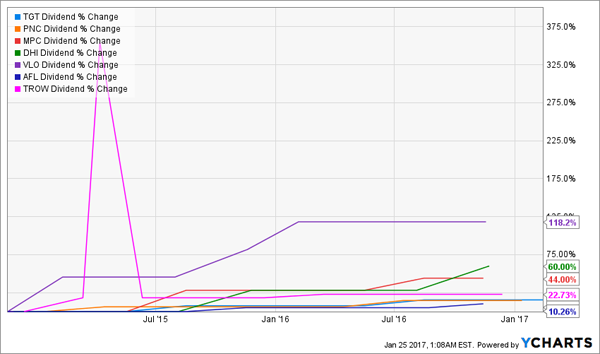
At the same time, five companies in our portfolio have seen stable payouts, excluding some special dividends from Costco:
Steady Income Stream
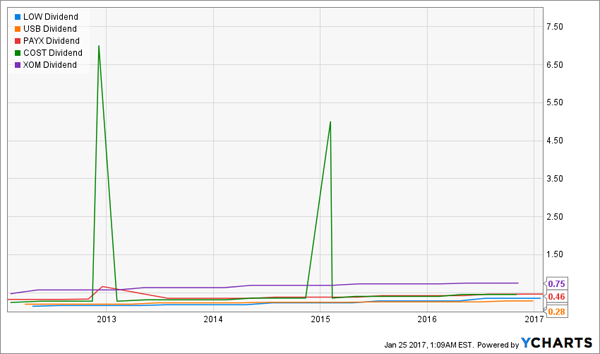
This doesn’t mean their payouts will necessarily remain stable over the next five years. Exxon’s dividend, for example, looked very shaky during the 2014 oil crash, but the company stuck with its payouts and continued to cover them with cash flow. Now that oil is up significantly from its recent lows and OPEC is planning a production freeze, Exxon’s dividend will likely get safer.
As for the rest of these stable dividend payers, one quick look at their dividend-payout ratios (or the percentage of earnings devoted to dividends) shows how much potential these companies have:
Low Payout Ratios
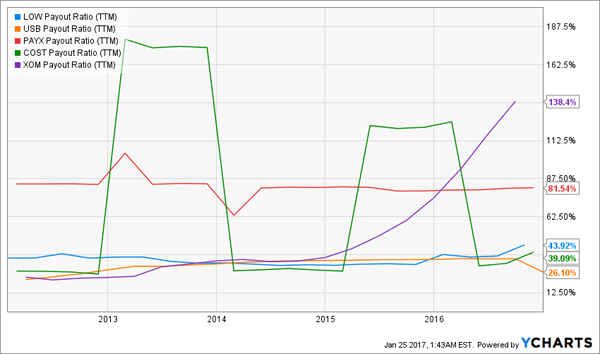
Paychex’s ratio has fallen slightly over the last five years and currently sits at a somewhat high 81%, but the other four have far lower payout ratios, leaving plenty of room for dividend hikes if management so chooses.
Still, let’s stay skeptical and assume dividends show zero growth at these five companies over the next decade.
Even with this ultra-conservative assumption, we’ll likely see our portfolio’s average dividend yield grow to 3.4% in the next five years and 4.3% in the next decade:
Strong Dividend Growth Across the Portfolio
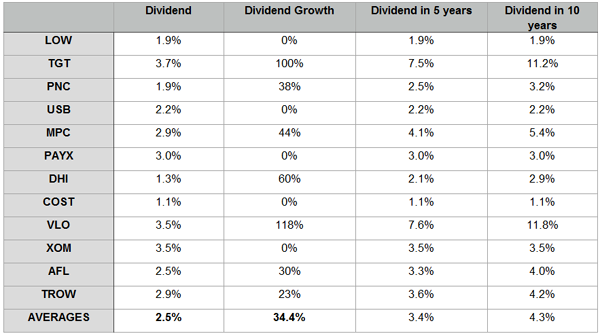
This will already help our income from the portfolio rise substantially, getting us to a yield over twice what the S&P 500 pays currently.
However, there’s a better reason to buy this portfolio. In addition to dividends, it has given investors substantial capital gains over the last five years, producing an annualized return of over 16%:
Strong Historical Returns
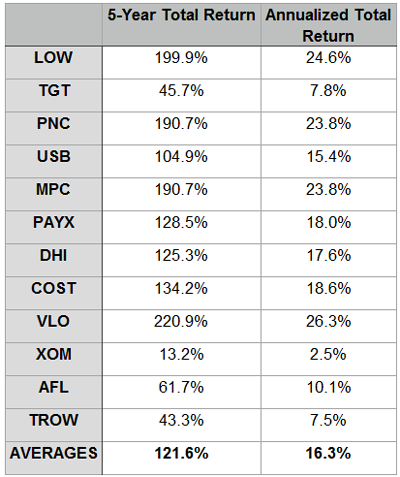
That’s significantly higher than the 13.9% total return for the S&P 500 over the same time period. You can also see from this chart that those returns are stable—meaning the portfolio’s volatility is minimal:
Low Volatility Means Low Anxiety Levels
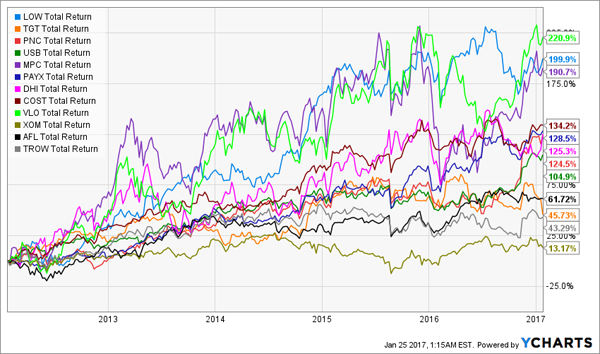
The worst returns in the portfolio came from Exxon as oil kept crashing, but that was offset by consistent positive gains over five years from every other stock in the portfolio.
You might worry that it’s too late to buy into this portfolio—the Trump rally is getting long in the tooth, and post-inauguration jitters have already caused volatility to spike.
That’s true for many stocks out there, but not these. While Paychex is close to its 52-week high, every other stock is far off its high point and only three have P/E ratios above the market as a whole:
Not Buying at the Top

While you aren’t buying at the bottom for any of these names, you’re buying far from the top—and you’re buying their earnings growth at a reasonable price. If you look at these companies’ earnings per share (EPS) growth over the last five years, you see strong increases across the board, again with the oil-impacted exception of Exxon:
Earnings Sharply Higher for the Group
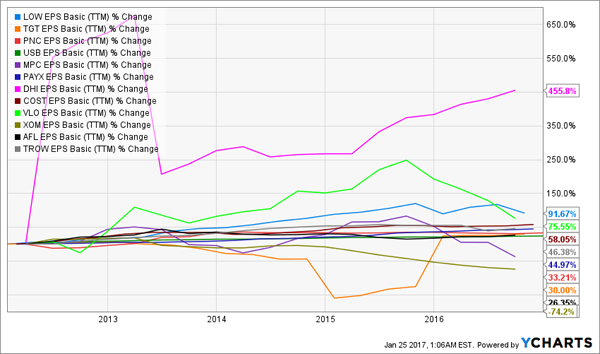
Buying into this portfolio now will help you enjoy the gains these growing and lower-risk firms offer. But I’d recommend buying gradually over time, as this is the kind of portfolio that’s ideally suited for a long-term investment horizon. Investors who buy in increments of $6,000 per year over the next 30 years, for example, would see their $500-per-month contributions turn into over $3.3 million in that time:
A Multi-Millionaire Portfolio in Three Decades
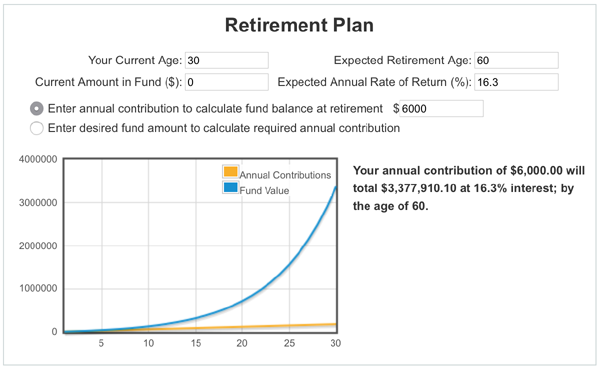
The bottom line? High value, dividend-paying, low-volatility companies are the key to growing a retirement nest egg over time even with modest contributions. But they’re just one of many tools investors can use to secure a future of financial independence.
The Sweet Spot: 8% Yields With Dividend Growth
As I just explained, blue chip dividend payers like these are a good place to look for income, even after the Trump rally. Trouble is, they rarely pay current yields more than 3% or 4%—and many are simply too popular or too expensive.
You’ll do even better focusing on stealth income plays such as closed-end funds, preferred shares and real estate investment trusts (REITs). In many cases, these issues pay secure yields of 8% or better—with dividend growth to boot!
This means you are assuring yourself of 10%+ annual returns, with most of that coming as cash dividends. These vehicles are safe, but they aren’t as well known as blue chips like Exxon, Costco or Lowe’s. And that’s a good thing for us, because we can lock up secure income streams of 8% or more while enjoying payout growth and price upside, to boot.
These stealth plays are the perfect investments for 2017. Regardless of Trump’s next tweet, these 8% payers are going to become increasingly popular with income investors as they’re discovered. Make sure you buy them now, before their prices get bid up (and their yields are compressed). Click here for the details about my favorite 8% plays in funds, preferreds and REITs—and I’ll share the names, tickers and buy prices with you, too.
